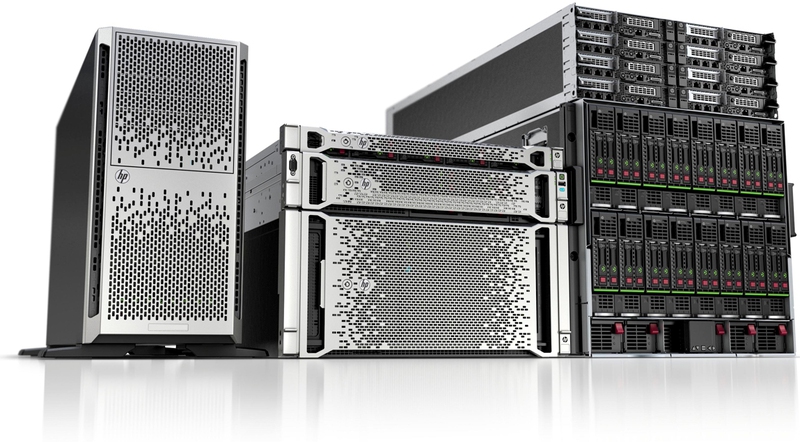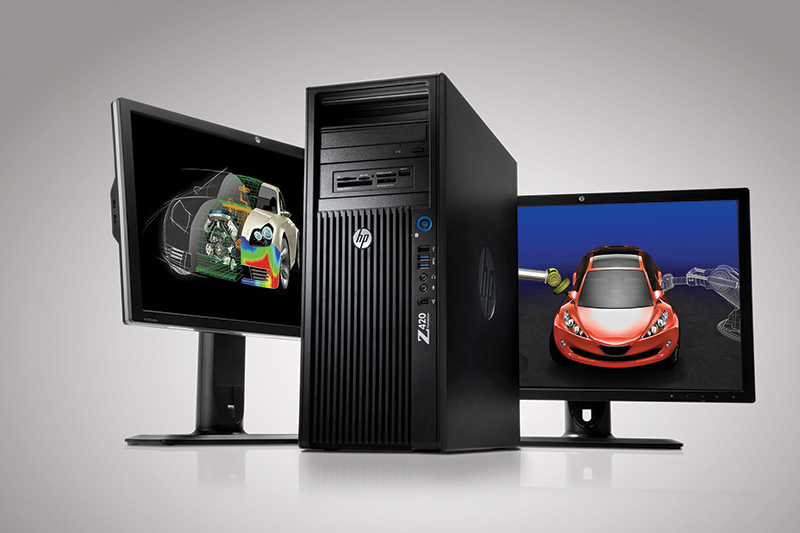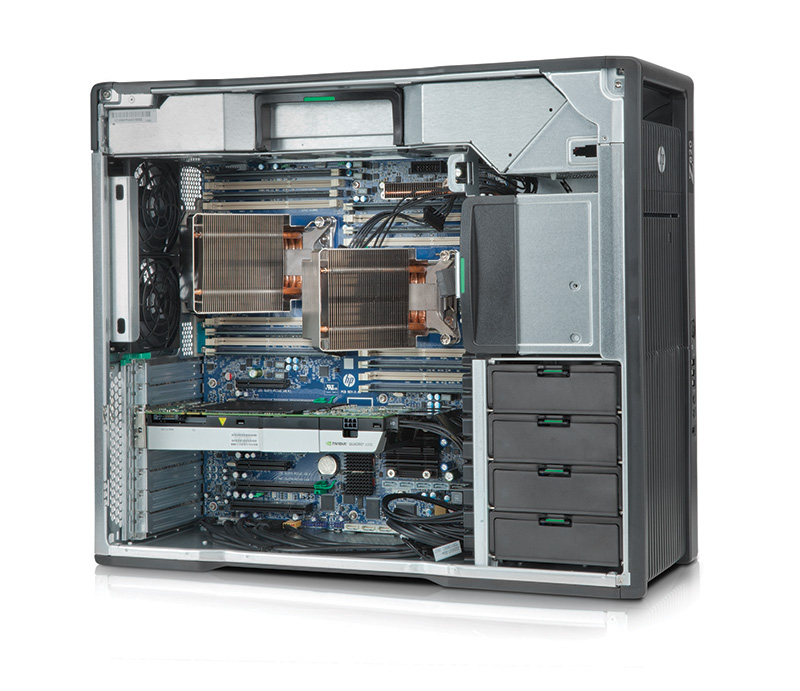02 - Thin Client and Fat Server
Have a great day everyone! In the last issue of our blog, we talked about what virtualization is and how it works in general terms. Today we will talk about the iron on which all this magnificence revolves.

The virtualized workplace does not work yet without hardware complexes that allow a person to interact with them. We have not grown to neural interfaces yet, so we will consider more mundane technologies.
Many have heard the expression “thin client”? In the years 2007-2008, thin clients caused more negative emotions than positive ones. Those that were truly subtle worked disgustingly, and those that worked well didn’t differ much from a regular computer in their design, respectively, and there wasn’t much use for them.
')
Today, the concept of “thin client” meets your expectations. In most cases, this is a box, the size of a home router, in which there are no moving parts, a complicated and expensive filling that requires attention or maintenance. The main difference between thin clients (except for the hardware features of some models) from the point of view of a company that decided to switch to virtualized workstations is the presence of a mini-OS inside the “workstations”.
There are two main approaches in the industry. Put a special Windows Embedded (its license is included in the cost of the device), based on Windows XP or Windows 7, or use the so-called. Zero-client , in which the entire OS occupies several megabytes, and is a Linux kernel and a set of micro utilities and services that provide loading, receiving network settings via DHCP and connecting to a server that will project the guest OS onto the client.
There is another approach that is used in our thin clients: Smart Zero . Difference from ordinary Zero-clients - in the amount of “firmware”. It is still significantly smaller than Windows Embedded, and occupies a couple of dozen megabytes, but contains a larger number of service utilities and a manager for diagnosing and configuring the network. Smart Zero also supports some proprietary technologies to speed up network deployment and install new workplaces, but we’ll better describe all the capabilities of our software in a separate topic. :)
What users are working on is more or less clear. What is the difference between a server and ordinary servers used for data storage or working with internal resources?

There are practically no fundamental hardware differences. Of course, it should be understood that the better (more powerful) the server, the more simultaneously connected clients it can contain.
As an example of a server for “virtualok” can be considered HP ProLiant Gen8 DL160. Classic "rack" server, which is often chosen in the SMB segment as a terminal server.
Inside, as usual, nothing extraordinary: ordinary server Xeons, a large amount of RAM, and a disk system for the server operating system. All features of the terminal server are in the software. And, since it so happened that Windows has de facto become standard in most offices around the world, we will consider software based on a Windows server.
In Windows Server, the components for the terminal server and the license manager for terminal clients are installed, and they are initially configured. After activating licenses for terminal OSs and initial configuration, the server lives its own life, and you don’t need to maintain it, in principle: once configured, it will ensure uninterrupted operation for all users using RPS or VDI for their needs.
Such a server can be supplemented with data storage systems with a higher reliability factor, powerful network equipment, and a highly reliable centralized solution can be obtained that will allow more than a dozen people to work without thinking that they have an “inferior” computer.
There is another interesting case: using a powerful workstation as a VDI server.

Suppose you are an engineer or designer, and you work in heavy packages that require really powerful equipment. A good multi-core processor, 32, 64, or even 128 gigabytes of RAM, Nvidia Quadro or Tesla, in general, is full of minced high-tech and you really know how to find a use for them.

And it so happens that you are far away from your workstation, and the project must be urgently edited, modified, shown, or even put on the next task. In this case, you simply connect from any device convenient to you to your computer, which becomes a server, and work with a virtual desktop, as if you do not have a kilogram of small bitten apples on your lap, but your powerful workstation.
With the general theory, we have finished, all the following posts - on specific practical examples. :) See you on the pages of Habr.
UPD from 22 Apr 2012: We launched a special project on Habré, which was described in the zero post of this season. It is located at: habrahabr.ru/special/hp/commercial and there is a lot of interesting information, the form of feedback we promised, as well as a test of knowledge in the field of virtualization. We are waiting for you and your questions!

The virtualized workplace does not work yet without hardware complexes that allow a person to interact with them. We have not grown to neural interfaces yet, so we will consider more mundane technologies.
Many have heard the expression “thin client”? In the years 2007-2008, thin clients caused more negative emotions than positive ones. Those that were truly subtle worked disgustingly, and those that worked well didn’t differ much from a regular computer in their design, respectively, and there wasn’t much use for them.
')
Today, the concept of “thin client” meets your expectations. In most cases, this is a box, the size of a home router, in which there are no moving parts, a complicated and expensive filling that requires attention or maintenance. The main difference between thin clients (except for the hardware features of some models) from the point of view of a company that decided to switch to virtualized workstations is the presence of a mini-OS inside the “workstations”.
There are two main approaches in the industry. Put a special Windows Embedded (its license is included in the cost of the device), based on Windows XP or Windows 7, or use the so-called. Zero-client , in which the entire OS occupies several megabytes, and is a Linux kernel and a set of micro utilities and services that provide loading, receiving network settings via DHCP and connecting to a server that will project the guest OS onto the client.
There is another approach that is used in our thin clients: Smart Zero . Difference from ordinary Zero-clients - in the amount of “firmware”. It is still significantly smaller than Windows Embedded, and occupies a couple of dozen megabytes, but contains a larger number of service utilities and a manager for diagnosing and configuring the network. Smart Zero also supports some proprietary technologies to speed up network deployment and install new workplaces, but we’ll better describe all the capabilities of our software in a separate topic. :)
What users are working on is more or less clear. What is the difference between a server and ordinary servers used for data storage or working with internal resources?

There are practically no fundamental hardware differences. Of course, it should be understood that the better (more powerful) the server, the more simultaneously connected clients it can contain.
As an example of a server for “virtualok” can be considered HP ProLiant Gen8 DL160. Classic "rack" server, which is often chosen in the SMB segment as a terminal server.
Inside, as usual, nothing extraordinary: ordinary server Xeons, a large amount of RAM, and a disk system for the server operating system. All features of the terminal server are in the software. And, since it so happened that Windows has de facto become standard in most offices around the world, we will consider software based on a Windows server.
In Windows Server, the components for the terminal server and the license manager for terminal clients are installed, and they are initially configured. After activating licenses for terminal OSs and initial configuration, the server lives its own life, and you don’t need to maintain it, in principle: once configured, it will ensure uninterrupted operation for all users using RPS or VDI for their needs.
Such a server can be supplemented with data storage systems with a higher reliability factor, powerful network equipment, and a highly reliable centralized solution can be obtained that will allow more than a dozen people to work without thinking that they have an “inferior” computer.
There is another interesting case: using a powerful workstation as a VDI server.

Suppose you are an engineer or designer, and you work in heavy packages that require really powerful equipment. A good multi-core processor, 32, 64, or even 128 gigabytes of RAM, Nvidia Quadro or Tesla, in general, is full of minced high-tech and you really know how to find a use for them.

And it so happens that you are far away from your workstation, and the project must be urgently edited, modified, shown, or even put on the next task. In this case, you simply connect from any device convenient to you to your computer, which becomes a server, and work with a virtual desktop, as if you do not have a kilogram of small bitten apples on your lap, but your powerful workstation.
With the general theory, we have finished, all the following posts - on specific practical examples. :) See you on the pages of Habr.
UPD from 22 Apr 2012: We launched a special project on Habré, which was described in the zero post of this season. It is located at: habrahabr.ru/special/hp/commercial and there is a lot of interesting information, the form of feedback we promised, as well as a test of knowledge in the field of virtualization. We are waiting for you and your questions!
Source: https://habr.com/ru/post/175823/
All Articles